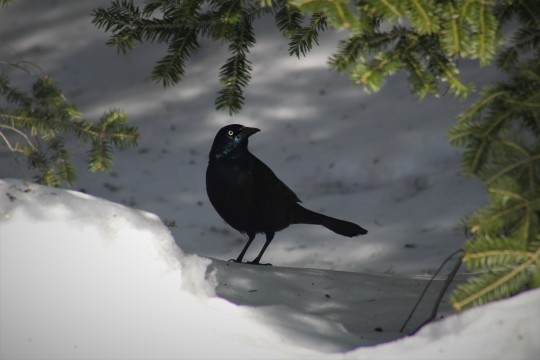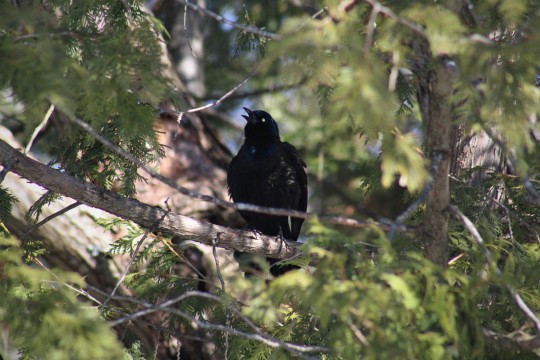#Icterids
Explore tagged Tumblr posts
Text

Red-winged Blackbird Agelauius phoeniceus
4/6/2022 Orange County, Florida
#bird#birds#bird photos#bird photo#bird photography#birblr#red-winged blackbird#blackbird#red wing blackbird#animals#animal photography#nature#wildlife#florida wildlife#wildlife photography#my photos#icteridae#icterids
510 notes
·
View notes
Text

Dolichonyx oryzivorus | Xanthocephalus xanthocephalus | Agelaius phoeniceus | Sturnella magna
Plate XXIX | Die Nordamerikanische Vogelwelt (1891)
#bird art#bird illustration#vintage art#vintage illustration#artists on tumblr#icteridae#icterids#bobolink#dolichonyx oryzivorus#blackbirds#yellow headed blackbird#xanthocephalus xanthocephalus#red winged blackbird#agelaius phoeniceus#eastern meadowlark#sturnella magna#anton goering
192 notes
·
View notes
Text





Feathursday Icterids
On this first Feathursday of the New Year, we present four members of the Icterid family of New World blackbirds that are common here in the Upper Midwest. From top to bottom, they are:
Yellow-headed Blackbird (Xanthocephalus xanthocephalus)
Red-winged Blackbird (Agelaius phoeniceus)
Bobolink, male and female (Dolichonyx oryzivorus)
Western Meadowlark (Sturnella neglecta)
This image is from a painting by the German naturalist artist and ornithologist Anton Göring ( 1836-1905), reproduced as a chromolithograph in our 2-volume set of Our Native Birds of Song and Beauty, by the late-19th-century director of the Milwaukee Public Museum Henry Nehrling (1853-1929), and published in Milwaukee by George Brumder (1839-1910) from 1893-1896.
View more posts from Nehrling’s Our Native Birds.
View more Feathursday posts.
#Feathursday#Icterids#blackbirds#New World blackbirds#Henry Nehrling#George Brumder#Anton Göring#Our Native Birds of Song and Beauty#Yellow-headed Blackbird#Red-winged Blackbird#Bobolink#Western Meadowlark#chromolithographs#Yay chromoliths!#birds#birbs!
29 notes
·
View notes
Text
On this day 2 years ago. I had goosebumps standing there. They flew so close to me!
Flock of grackles and maybe some red-winged blackbirds. I love how I could hear their wings at the beginning.
2K notes
·
View notes
Text



#CommonGrackel
…with all these temperature variations around here, no one can really be sure if it's Spring Season.
But today a small flock of these magnificent Common Grackels has arrived to enjoy the sun with us so, it's official now. We're in!
#Common Grackel#Grackel#FeederWatch#Passerine Bird#Icterid Family#Photography#IUCN#Spring#Mountainous Parts of the Northern Hemisphere#Canada#The RavenKeeper#birds#bird photography#Birders
492 notes
·
View notes
Text

Migratory May Day 10: Common Grackle
Reference photo by Michael O'Brien
#migratory may#common grackle#grackle#icterid#quiscalus quiscula#quiscalus#icteridae#passeriformes#bird#birb#birds#birbs#bird art#art#digital art#artists on tumblr#tw eyestrain#cw eyestrain#wauk wauk
59 notes
·
View notes
Text




west shared with @starryelem
#ibvs#isaac beamer versus the supernatural#dreamswap#nevin jovel#drew jovel#dev doodles#felix wolfe#james blackburn#wwoll#isaac beamer#edward quinton#icterid “starling” fink#western “cypher-text” bradford#bluetooth#paintedwings
24 notes
·
View notes
Note
trick or treat!
I am just a brown headed cowbird . I'm not a cuckoo but I believe in their beliefs O_O
Why hello there! You are so lovely, may you grow big and strong with all these treats!

Brown-headed cowbird (Molothrus ater) begging from chipping sparrow parent (Spizella passerina) by Kathy Ward, shared under CC BY-NC.
9 notes
·
View notes
Note
Hi Isa! i recently found out that is ship child floating around. Can you draw one, their is a painted wings one i think by unagidevi i like ( ͡^ ͜ʖ ͡^ )
-🌸
Hi Sakura! Yes I can draw them!

#Can’t believe I forgot to post this yesterday#icterid ‘starling’ fink#dreamswap#paintedwings#we are curiosity#isaacballz#sakura anon
12 notes
·
View notes
Text
you can get so much mileage out of naming a character after a bird
#the caged bird imagery man.#fluttering. soaring. group movement and breaking away. preening#brians beam saber pc tanager mercy#realis npc icterid#junco st james x 2#tha multiple characters named robin ive had over the years...
5 notes
·
View notes
Text
I went on my first date a few weeks ago and while I did not have any strong or sudden feelings about him, I may have to reevaluate that, as he has just sent me—without prompting—fish content. When I texted him back pictures of my shrimp, he very appropriately responded “Shrimps?!”
#if you follow icterid-rubus then you may be aware of my dating saga#yes at the ripe old age of 27 I have finally gone out on my first date. i have also for the first time ever held hands with someone.
6 notes
·
View notes
Text

Great-tailed Grackle Quiscalus mexicanus
7/25/2023 Valle Escondido Preserve, Costa Rica
#great tailed grackle#grackle#grackles#blackbirds#icterids#icteridae#costa rica#monteverde#rainforest#puntarenas#central america#bird#birds#bird photography#wildlife#nature#nature photography#wildlife photography#birding#birdwatching#my photos
95 notes
·
View notes
Text

Icterus bullockii | Icterus cucullatus nelsoni | Icterus parisorum | Pyrocephalus rubinus mexicanus
Plate XXXI | Die Nordamerikanische Vogelwelt (1891)
#bird art#bird illustration#vintage art#vintage illustration#artists on tumblr#anton goering#new world blackbirds#icterus bullockii#icterus cucullatus#icterus parisorum#pyrocephalus rubinus#icterids#icteridae
168 notes
·
View notes
Text
Blue Jay (Cyanocitta cristata)
Baltimore Oriole (Icterus galbula)
Tree Swallow (Tachycineta bicolor)
American Redstart (Setophaga ruticilla)
Orchard Oriole (Icterus spurius)
Ruby-Throated Hummingbird (Archilochus colubris)
Black-and-White Warbler (Mniotilta varia)
American Goldfinch (Spinus tristis)
Rose-Breasted Grosbeak (Pheucticus ludovicianus)
Indigo Bunting (Passerina cyanea)
Yellow Warbler (Setophaga petechia)
Cedar Waxwing (Bombycilla cedrorum)
Northern Cardinal (Cardinalis cardinalis)
Cute birds appreciation post
#wildlife#birds#corvid#jay#Blue Jay#icterid#blackbird#oriole#Baltimore Oriole#swallow#Tree Swallow#warbler#redstart#American Redstart#Orchard Oriole#hummingbird#Ruby Throated Hummingbird#Black and White Warbler#finch#goldfinch#American Goldfinch#cardinal#grosbeak#Rose Breasted Grosbeak#bunting#Indigo Bunting#Yellow Warbler#waxwing#Cedar Waxwing#Northern Cardinal
85K notes
·
View notes
Text
Nearly a year after making it, I’ve just realized I misspelled my Reddit username. It’s driving me up the wall.
0 notes
Text
Why I haven't been very active:
I'm working on two different animations, getting a little bit tired of art while I work on them
I start a project and suddenly I feel like it can't be fixed
So if I stop posting for a little while I'm probably caught up with life
Characters Icterid and West shared with @starryelem
#dreamswap#dreamtale au#undertale au#art#artwork#undertale#digital art#dev ideas#icterid 'starling' fink#western 'cypher-text' bradford#ds ink#dreamswap ink#ds finch#dreamswap finch
27 notes
·
View notes